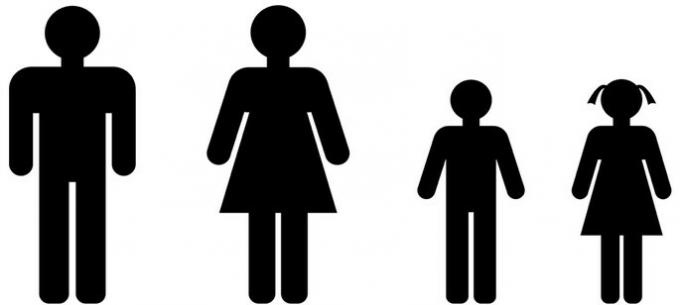The 8 types of variables in research and examples
A variable is something that can have different values, such as weight, height, or eye color, as opposed to a constant that only has one value, such as the speed of light.
The types of variables are determined by the data it represents. For example, weight is a quantitative variable when expressed in numbers as grams or kilograms of an object. Whereas if it is presented in terms of "heavy" or "light", it would be a qualitative variable, because it presents a quality.
We use different types of variables in mathematics, statistics, and in scientific research. Let's see.
1. Continuous quantitative variable

A continuous quantitative variable is any variable represented by numbers that can be expressed by fractions or decimals such as temperature, where we find values such as 37 ºC, 37.5ºC or 38.5ºC.
Other examples of variables are:
- Levels of a compound in the blood- The blood sugar levels of a person with diabetes for a day can be 7.5 mM, 8.3 mM or 5.0 mM.
- The measurement of atmospheric pressure: at 0 meters above sea level the atmospheric pressure is equal to 1 atm and at 1000 meters above sea level it is equal to 0.887 atm.
- The mass of an objectAvocados from a tree can measure 200.5 grams, 201 grams, or 205.2 grams.
- The length of an object: the height of trees in a park.
2. Discrete quantitative variable

A discrete quantitative variable can only take integral values, that is, 1, 2 or 555, but not 1.5 or 2.25. Examples of these types of variables are:
- The number of times something happens: the times it rained each month in 2020 in Bogotá.
- The number of times someone assumes a certain behavior: how many times people over 50 participate in a marathon.
- The number of people or beings in a group: the number of students in a classroom can only be an integral value, there cannot be a fraction of a student.
- The number of objects in a place: the number of chairs or books in each classroom of a school.
3. Dichotomous qualitative variable

The qualitative dichotomous variable is a non-numerical data that presents an observable quality, property or condition, that only presents two values. For example:
- ANDThe verdict of a jury: "guilty" or "not guilty".
- Sex: "male or female".
- The result of an antigen test: "positive or negative".
- Presence of a condition: "present" or "absent".
- The type of hospital: "public" or "private".
4. Qualitative categorical or nominal variable
It is the non-numerical variable that presents three or more categories. For example:
- Affinity for a team: In Mexican soccer you can be a fan of "the Atlas Fútbol Club", "Club América" or "el club León".
- Olympic sports: "swimming", "volleyball", "athletics", "fencing" or "gymnastics".
- The states of matter: "solid", "liquid" or "gaseous".
- College careers: "biology", "law", "medicine", "nursing" or "economics".
5. Ordinal variables
Values can be ordered from least to greatest, most important to least important, first to last, and so on. We observe this type of variable in:
- Social class: "lower class", "middle class" or "upper class".
- Socioeconomic level: A / B (rich class), C + (upper middle class), C (middle class), D + (lower middle class), D (poor class), E (extreme poverty).
- Language proficiency: "basic", "intermediate" or "advanced".
- College grades: first degree, second degree, third degree, etc.
6. Independent variable
The independent variable is a variable that occurs without the need for another. In science, it is the variable manipulated or controlled by the researcher. That is, values can be attributed at will within certain limits. For example, in the study of the effects of a drug, the independent variable can be qualitative if there is a control group without drugs and a group with treatment.
Scientific studies generally focus on examining the effects of an independent variable. In one study the impact of five intensities of a magnetic field on barley plants was analyzed. In this case, the independent variable was the intensity of the magnetic field.

7. Dependent variable
The dependent variable is a variable that is a consequence of another. For example, children's height is an age-dependent variable. A 10-year-old is taller than a 5-year-old.
The dependent variable is the measure of the effect of the independent variable. In one study, waist circumference was measured in two groups of women, a control group and another group that practiced dance therapy for eight weeks. The dependent variable is waist circumference, while dance regimen is the independent variable.
The easiest way to identify a dependent variable is by detecting the effect or consequence of something, that is, the independent variable that is the cause. As in the previous case, dance practice is the cause or independent variable and the consequence is on the waist measurement or dependent variable.
While the independent variable is manipulated or fixed, the dependent variable is measured or recorded.
8. Strange independent variable
They are those independent variables that are not related to the purpose of the study, but that can affect the dependent variables.
An example of a strange variable is intelligence in a study of the effects of eating breakfast and the results of a math test in a group of students. The independent variable is assumed to be whether or not to eat breakfast before taking a math test. The test results would be the dependent variable, however, in this case, the intelligence of each child could influence the result.
You may also be interested in seeing:
- Descriptive and inferential statistics
- Population and sample
References
Ercan, I, et al (2021) Magnetic field effects on the magnetic properties, germination, chlorophyll fluorescence, and nutrient content of barley (Hordeum vulgare L.) Plant Physiol. Biochem. 170:36-48. doi: 10.1016 / j.plaphy.2021.11.033.
Hernández-Sampieri, R., Fernández Collado, C., Baptista Lucio, P. (2014) Research methodology 6th ed. McGraw-Hill. Mexico.
Marczyk, G., DeMatteo, D., Festinger, D. (2005) Essentials of research design and methodology. Jon Wiley & Sons. New Jersey.

